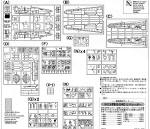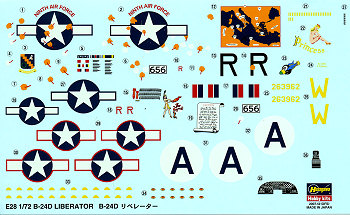
Hasegawa 1/72 B-24D Liberator
| KIT: | Hasegawa 1/72 B-24D Liberator |
| KIT #: | 00558 |
| PRICE: | 5200 yen at www.hlj.com |
| DECALS: | Two options |
| REVIEWER: | Scott Van Aken |
| NOTES: |

| HISTORY |
Often compared to the better known B-17 Flying Fortress, the B-24 was a more modern design with a higher top speed and greater range yet it had a similar bombload and defensive armament. Nevertheless, popular opinion among aircrews and general staff tended to favor the B-17's rugged qualities above all other considerations. The B-24 was notorious among American air crews for its tendency to catch fire. The placement of the B-24's fuel tanks throughout the upper fuselage and its lightweight construction, designed both to increase range and optimize assembly line production, made the aircraft vulnerable to battle damage. The B-24 was more difficult to fly as well, with heavy control forces and poor formation flying characteristics. The B-24 nevertheless provided excellent service in a variety of roles thanks to its large payload and long range.
The B-24D and subject of this kit, was the first model produced on a large scale; ordered from 1940 to 1942, as a B-24C with better engines (R-1830-43 supercharged engines). During the production run, the tunnel gun in the belly was replaced by a remote-sited Bendix belly turret; this was later replaced by a Sperry ball turret. In late B-24Ds, 'cheek' guns were added. (Total: 2696: 2381 Consolidated, San Diego; 305 Consolidated, Fort Worth, ten Douglas, Tulsa, Oklahoma).
| THE KIT |
 The
long awaited Hasegawa B-24D has arrived and I have to say it is quite a model.
Small this plane is not and the mass of sprues just shows that Hasegawa is fully
planning on doing an entire series of aircraft. Perhaps even the LB-30 as the
entire nose section from the cockpit transparencies forward is made of clear
plastic. The clear sprue also includes a number of different bits and pieces,
including many that will not be appropriate for the D model. Gaps on the ends of
this sprue show that other noses are going to be done, which is good as that is
one of the few ways of telling the later variants apart.
The
long awaited Hasegawa B-24D has arrived and I have to say it is quite a model.
Small this plane is not and the mass of sprues just shows that Hasegawa is fully
planning on doing an entire series of aircraft. Perhaps even the LB-30 as the
entire nose section from the cockpit transparencies forward is made of clear
plastic. The clear sprue also includes a number of different bits and pieces,
including many that will not be appropriate for the D model. Gaps on the ends of
this sprue show that other noses are going to be done, which is good as that is
one of the few ways of telling the later variants apart.
Due to the number of sprues and the size of the parts, I thought a scan of the parts trees from the instruction sheet would be more useful. Hasegawa mold quality has been high for 20 plus years and I see no change in that on this kit. The vast majority of this kit will be the same from variant to variant. That will include the wings, tail planes, most of the fuselage, bomb bad detail and so on. The B-24 was a very tail heavy plane in service, needing concrete blocks to hold it on the nose wheel if more than one engine was removed for servicing or replacement. This kit will be no different, though there is not much room far forward to place weight.
Cockpit is basic with decals being used for the
instrument panel. There is a full bomb bay that can have the doors posed open or
closed as one wishes. Normally these doors were open on the ground to keep
moisture from collecting in them. Each engine has fore and aft cylinders ,
though the engines themselves are generic. Upper and lower cowling halves with a
single forward section are given and the mounts are keyed to inner or outer
engines. Full and appropriate turrets are given which can be installed after the
airframe is done. This is a huge help for painting. The side guns can be posed
sticking out of their doors or with the doors installed. There are also nose
guns provided and depending on which marking option yo u
use will determine which holes are opened.
u
use will determine which holes are opened.
Standard Hasegawa instructions with Gunze paint references. Markings for two planes. One is the box art aircraft in desert pink with neutral grey undersides as operated by the 98th BG in Italy during 1943. It seems to me that this one is decked out for a US war bond tour as I doubt if they'd have had the bullet holes annotated or a listing of the bases on a large map on the nose during combat ops. The other is from the 44th BG and names 'Princess' as operated in mid-late 1943, judging from the red surround insignia. Fortunately, before Aeromaster changed hands they did several 1/72 B-24 sheets and you should consider trying to find one if you want something a bit different. Decals are well printed and modern Hasegawa sheets have shown they can handle setting solutions without any problems.
| CONCLUSIONS |
So there you have it. Hasegawa continues its release of WWII bombers with one that many have been asking for. I would be willing to bet that we'll be seeing an H or J within a year. For now, this one looks great and I'm sure that you'll be pleased with the results.
| REFERENCES |
http://en.wikipedia.org
January 2008
My thanks to www.hlj.com for the
review copy. You can get yours at Japanese prices from the link.
If you would like your product reviewed fairly and quickly, please
contact
me or see other details in the
Note to
Contributors.